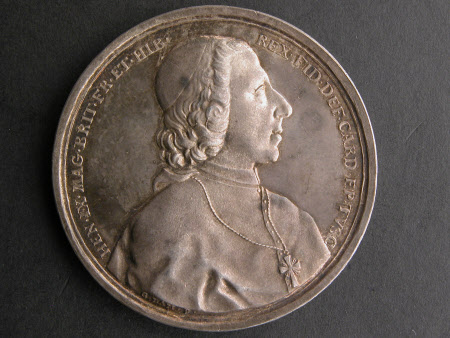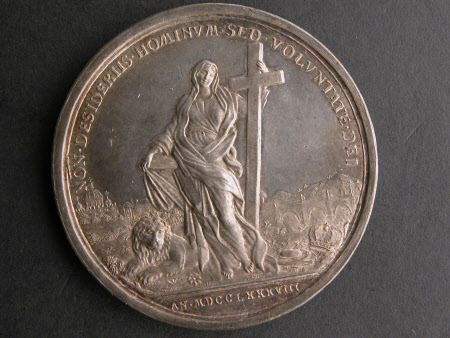Prince Henry Benedict Stuart, Cardinal Duke of York
Gioacchino Hamerani (Rome 1766 - Rome 1796)
Category
Coins and medals
Date
1788
Materials
Silver
Measurements
527 mm (Diameter)
Place of origin
Rome
Order this imageCollection
Osterley Park and House, London
NT 773313
Summary
Silver, Prince Henry Benedict Stuart, Cardinal Duke of York, attributed to Gioacchino (1761-1797) or Giovanni Hamerani (1763-1846), struck Rome, Italy, 1788. A silver medal attributed to Gioacchino or Giovanni Hamerani depicting Henry Benedict Stuart, Cardinal Duke of York (1725-1807). On the obverse the Cardinal depicted facing right in ecclesiastical vestments, a cross on a chain around his neck. The Latin legend translates as: ‘Henry IX, King of Great Britain and Ireland, Defender of the Faith, Cardinal Bishop of Tusculum’. The artist’s signature on the truncation of the bust. Reverse depicts an allegorical figure of Piety standing, a Cross and book in her hand, to her sides a lion, cardinal’s hat and a crown. In the distance are St. Peter’s and a view of the Tiber. Legend translates as: Not by the desires of men, but by the will of God.’ The exergue bears the date, 1788.
Full description
Henry Benedict Stuart was the younger brother of Prince Charles Edward Stuart, the Young Pretender and, as such, the second-in-line to the throne according to supporters of the Jacobite cause. Prince Henry Benedict became cardinal-deacon of the Catholic church in 1747, a year after the defeat of Bonnie Prince Charlie at Culloden, and subsequently enjoyed a successful career within the church. On 1 September 1748, he was ordained a priest, which removed any final hopes that he might marry and produce heirs. In 1758 Henry was created Cardinal York and Chamberlain of the Sacred College of Cardinals and, in 1761, Cardinal-Bishop of Frascati. Prince Henry’s decision to enter the hierarchy of the Catholic church reflected his belief, as well as that of his father King James VIII and III (‘The Old Pretender, 1688-1766), that the opportunity for restoration had passed and that, with the defeat at Culloden, the Jacobite cause had been lost. This was not the opinion of Henry’s brother Charles, who regarded his sibling’s move as a betrayal of himself as well as the Jacobite cause more broadly, since such a close affiliation to the Papacy meant that the Stuart claim could not realistically be pursued by Prince Henry. Prince Charles Edward Stuart died on 31 January 1788, never having been recognised as the rightful king by the Pope. This left the Cardinal Duke of York as the final Jacobite heir formally to lay claim to the thrones of Great Britain, France and Ireland. Henry made no attempt in his lifetime to enforce this claim, although in this medal commissioned from the Hamerani, he is described in the legend as King Henry IX, and was known privately by this title. The reverse of the medal copies with minor variations the reverse of the medal of the Cardinal Duke of York, made some two decades earlier in 1766, by Filippo Cropanese (NT 773275), following the death of the Cardinal’s father, Prince James. The reuse of the reverse was perhaps intended by the Cardinal Duke of York to emphasise the firmness of his belief in his faith, as the way forward. The Cardinal recorded in his diary for 10 August 1788 the delivery of the ‘new large medal’ (‘nuova grande medaglia’). There are three variants of the medal, with different positioning of the chain supporting the Cardinal’s Cross on the obverse, and minor differences in the details of the design and the legend on the reverse. There is another unsigned version of the medal in copper at Osterley Park (NT 773315). The wax on slate models for both sides of the medal are in the British Museum (Jack Hinton, ‘Forming designs, shaping medals: a collection of wax models by the Hamerani’, The Medal, 41 (Autumn 2002), pp. 3-57, pp. 44-47, nos. 98-99). Jeremy Warren 2019
Provenance
Given to the National Trust in 1993 by George Child Villiers, 9th Earl of Jersey (1910-1998).
Marks and inscriptions
Obverse, legend: HEN. IX. MAG. BRIT. FR. ET. HIB. REX. FID. DEF. CARD. EP. TUSC Obverse, truncation: G. HAM. F. Reverse, legend: NON. DESIDERIIS. HOMINVM. SED. VOLVNTATE. DEI Reverse, exergue: AN. MDCCLXXXVIII
Makers and roles
Gioacchino Hamerani (Rome 1766 - Rome 1796) , medallist Giovanni Hamerani (1763 - 1846), medallist
References
Cochran-Patrick 1884: Robert William Cochran-Patrick, Medals of Scotland from the earliest period to the present time, Edinburgh 1884, p. 77, no. 69. Skeet 1930: Francis John Angus Skeet, Stuart Papers, Pictures, Relics, Medals and Books in the Collection of Miss Maria Widdrington, Leeds 1930, p. 76. Brown 1980: Laurence Brown, A catalogue of British historical medals 1760-1960, Vol.I. The accession of George III to the death of William IV, London 1980, p. 67, no. 282. Woolf 1988: Noel Woolf, The Medallic Record of the Jacobite Movement, London 1988, pp. 132-33, no. 73:1. Eimer 2010: Christopher Eimer, British Commemorative Medals and their Values, London 2010, p. 123, no. 823, Pl. 93.

